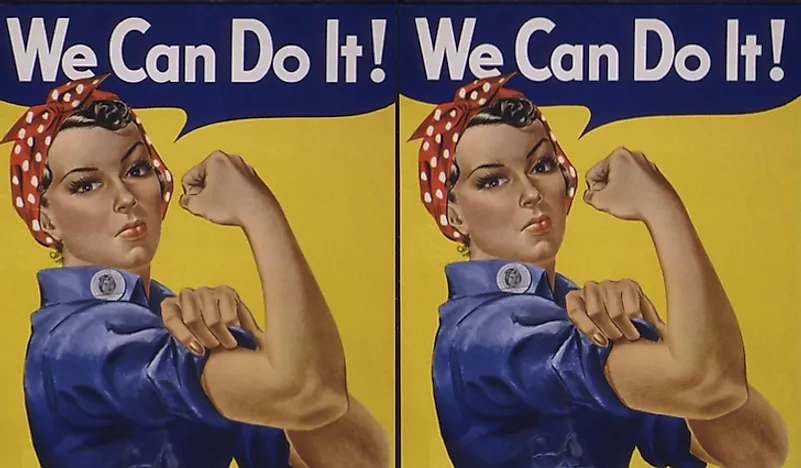Who Was Rosie the Riveter? Was Rosie the Riveter a Real Person?

Rosie the Riveter was an iconic image that represented working women during World War II. Upon the beginning of the U.S. involvement in World War II, American men flocked to enlist into the Armed Forces, leaving significant holes in the industrial labor force. Rosie the Riveter was a character designed to encourage women to join the workforce and fill the job vacancies. It was created by the government's War Manpower Commission and the War Production Board.
But who was Rosie the Riveter? Was she a real person? There are many beliefs about the origin of the real Rosie. However, the common belief is that "Rosie" was based on a woman by the name of Naomi Parker. In 1942, Parker was working in a machine shop at the Naval Air Station when a photographer snapped a shot of her on the job. Parker was dressed in blue coveralls, sensible heels, and her hair tied back in a polka-dot bandana. No matter who the original Rosie was, all the Rosies contributed to the war effort and helped build a booming post-war economy.
Women and the World War II Workforce
Previous to World War II, women were not encouraged to participate in the workforce. The U.S. was coming out of the Great Depression, and any available jobs went to men first. The Depression ended when the U.S. entered WWII, and so did the notion of a men's only workforce.
The economy during WWII provided women with the opportunity to earn their living and contribute to the war effort. The campaign’s message was simple: entering the workforce to support the troops was a patriotic duty. As the men went off the war, it was now up to the women to make sure they kept the country running, and the tools and weapons soldiers needed to win the war.
Early Appearances
Incidentally, Rosie the Riveter was first a song by written songwriters John Jacob Loeb and Redd Evans in 1942. The Rosie the Riveter song became a favorite patriotic tune sung by The Four Vagabonds that inspired a campaign to get women into the workforce.
The first appearance of Rosie the Riveter was on the Saturday Evening post painted by Norman Rockwell in 1943. In the painting, Rosie is dressed in blue coveralls, red bandana covering her hair and is stomping on a copy of Adolf Hilter's, Mein Kampf. Later, the United States government popularized a more feminine version of the Rockwell painting. The iconic poster was painted by American artist J. Howard Miller for Westinghouse Electric Corporation, along with the slogan, “We Can Do It!”
Effectiveness
Women heeded the call and fulfilled their patriotic duty. Women entered the workforce in unprecedented numbers never before seen in women's history. They took over men's jobs, and built aircraft, ammunition or whatever was needed for the war. By 1944, one-third of workers on the defense were also homemakers full-time. In a statistic never before paralleled in U.S. history, single women workers outnumbered married women. In many cases, women continued to be the primary child caregivers and homemaker, while also taking a full-time job.
After the War
The end of WWII brought the end of the careers for many women. However, many women enjoyed working and stayed in the workforce. Some did fight gender and racial discrimination to stay employed in her factory once the men returned from the front. These Rosies furthered the women's rights movement started by nearly a hundred years ago by the first women's suffragettes.
No matter what paths the “Rosie the Riveters” took after the war, they are remembered for their ability to maintain the home front and contribute to the war effort.











